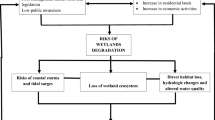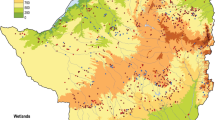Abstract
The Greater Accra Metropolitan Area (GAMA), in Ghana, has witnessed the destruction of approximately 60% of its wetlands. Wetlands provide many valuable ecological, social, economic, and recreational functions. Appreciation of the importance of wetlands has increased in recent years, consequently, wetland protection has been recognized globally through international agreements, as well as through national, regional, and local policies and regulations. Empirical studies on wetland destruction in urbanized Ghana are limited. Adopting a qualitative approach, this research examines the causes and extent of wetland destruction in the GAMA. The study reveals that measures designed and implemented to protect wetlands in the GAMA have proved ineffective due to non-implementation and monitoring of wetland protection strategies, policies and projects. These shortcomings reflect a lack of resources and participation of stakeholders in the planning, development and implementation of wetland protection policies. The study concludes with a recommendation for more direct participation of stakeholders in developing and implementing plans and strategies to manage wetlands in Ghana.



Similar content being viewed by others
References
African Conservation Foundation (2015) Wildlife Division of the Forestry Commission; Area of Operation; Ghana. http://www.africanconservation.org/explorer/wildlife-division-of-the-forestry-commission-2 (Accessed 18 Feb 2015)
Amankwah CC (1998) Coastal Wetland Management Project. Wildlife Department, www.wetlands.org/RSIS/_COP9Directory/Directory/ris/1GH004en.pdf (Accessed 11 Sept 2015)
Asiedu AA (2015). Adomonline.com.http://www.m.adomonline.com/marticles/news/planners-surveyors-should-be-ashamed-over-accra-floods%2D%2Dgip-president (Accessed 18 April 2017)
Asimah R, Dankwa H, Biney CA, Amankwah CC (2008) Trends analysis relating to pollution in Sakumo lagoon, Ghana. African Journal of Aquatic Science 33(1):87–93
Attuquayefio D, Gbogbo F (2001) Prospects of conserving wetlands along the Mukwe lagoon at Nungua in the greater Accra region of Ghana. West African Journal of Applied Ecology 2(1):65–75
Barbier EB, Acreman M, Knowler D (1997) Economic valuation of wetlands: a guide for policy makers and planners. Ramsar convention bureau, Department of Environmental Economics and Environmental Management, University of York, Institute of Hydrology, ICUN – the world conservation union, Cambridge, England, 135 pp.
Carter V (1996) Wetland hydrology, water quality and associated functions. In: Fretwell JD, Williams JS, Redman PJ (eds) National Water Summary on Wetland Resources. USGS Water-Supply Paper, vol 2425. USDI, Geological Survey, Washington, DC, pp 35–48
Center for African Wetlands (2010) About Center for African Wetlands, http://www.afriwet.org/_home/Center%20for%20African%20Wetlands%20-%20University%20of%20Ghana_about%20CAW.html (Accessed 18 Feb 2015)
ClientEarth (2013) An overview of the legal framework of the forest and wildlife sector. www.clientearth.org
Convention on the Conservation of Migratory Species of Wild Animals (CMS) (2014) About CMS. http://www.cms.int/en/legalinstrument/cms
Council for Scientific and Industrial Research (CSIR) (2015). Background of Council for Scientific and Industrial Research-Ghana, http://www.csir.org.gh/ (Accessed 18 Feb 2015)
Ehrenfeld JE (2000) Evaluating wetlands within an urban context. Ecological Engineering 15:253–265
Environmental Protection Agency (EPA) (1994) Environmental Protection Agency Act 490, Accra, Ghana
Fong P, Boyer KE, Zedler JB (1998) Developing an indicator of nutrient enrichment in coastal estuaries and lagoons using tissue nitrogen content of the opportunistic alga, Enteromorpha intestinalis (L. Link). Journal of Experimental Marine Biology and Ecology 231(1):63–79
Gbogbo F (2007) Impact of commercial salt production on wetland quality and water birds on coastal lagoons in Ghana. Ostrich: Journal of African Ornithology 78(1):81–87
Ghana Statistical Service (GSS) (2012). 2010 population and housing census report. Ghana Statistical Service, Accra
Gordon C, Yankson K, Biney CA, Tumbulto JW, Amlalo DS, Kpelle D (1998) Report of the Working Group on Wetland Typology. Report to Ghana Coastal Wetlands Management Project, Ghana Wildlife Department, Accra
Hoog G, Steinmetz A (1993) International conventions on protection of humanity and environment. Walter de Gruyter & Co, Berlin
Jan KJ, Ens B, Piersma T, Zwarts L (2004) Shorebirds: an illustrated behavioral ecology. In: KNNV publishing. Zeist, Netherlands
Karley NK (2009) Flooding and physical planning in urban areas in West Africa: situational analysis of Accra, Ghana. Theoretical and Empirical Researches in Urban Management 4(13):25–41
Kasanga K, Kotey NA (2001) Land Management in Ghana: building on tradition and modernity. International Institute for Environmental and Development, London
Kondra M (2016) WaterPower Working Paper Series
Kroodsma DE (1979) Habitat value for nongame wetland birds. In: Greeson PE, Clark IR, Clark JE (eds) Wetland functions and values: the state of our understanding. American Water Resources Association, Minneapolis, pp 320–343
Larbi A, Duguma B, Smith JW, Mollet M, Akinlade A (1998) Edible forage production, chemical composition, rumen degradation and gas production characteristics of Calliandra calothyrsus (Messin) provenances in the humid tropics of West Africa. Agroforestry Systems 39:275–290
Mensah J (2005) Problems of district medium-term plan implementation in Ghana. International Development Planning Review 27(2):245–270
Ministry of Food and Agriculture (2015). About Ghana Irrigation Development Authority, http://mofa.gov.gh/site/?page_id=2976 (Accessed 18 Feb 2015)
Ministry of Lands and Forestry (1999). Managing Ghana’s Wetlands: A National Wetlands Conservation Strategy. Ministry of Lands and Forestry, Accra, Ghana
National Development Planning Commission (2010) Ghana Shared Growth and Development Agenda, Accra, Ghana
National Development Planning Commission (NDPC) (2010) Ghana Shared Growth and Development Agenda. National Development Planning Commission, Accra, Ghana
Ntiamoa-Baidu Y (1988) Ferns in Coastal Ghana. Proceedings of the 7th Pan African Ornithological Congress, Nairobi, Kenya, pp. 37–43
Ntiamoa-Baidu Y (1991) Seasonal changes in the importance of coastal wetlands in Ghana for wading birds. Biological Conservation 57:139–158
Ntiamoa-Baidu Y (2008) Indigenous beliefs and biodiversity conservation: the effectiveness of sacred groves, taboos and totems in Ghana for habitat and species conservation. Journal for the Study of Religion, Nature and Culture 2(3). https://doi.org/10.1558/jsrnc.v2i3.309
Ntiamoa-Baidu Y, Gordon C (1991) Coastal wetland management plans: Ghana. Environmental resource management project. World Bank and Environmental Protection Council, Accra, Ghana
Ntiamoa-Baidu Y, Hepburn IR (1988) Wintering waders in coastal Ghana. RSPB Conservation Review 2:85–88
Ntiamoa-Baidu Y, Nyame SK, Nuoh A (2000) Trends in the use of a small coastal lagoon by water birds: muni lagoon (Ghana). Biodiversity and Conservation 9:527–539
Nyarko BK (2002) Application of a rational model in GIS for flood risk assessment in Accra. Ghana Journal of Spatial Hydrology 2(1):1–14
Oregon State University (2008) Sustaining multiple functions for urban wetlands. Institute for Water and Watersheds, Oregon State University. http://water.oregonstate.edu/wetlands/about.html. Accessed 20 March 2016
Oteng-Yeboah AA (1999) Biodiversity studies in three coastal wetlands in Ghana, West Africa. Journal of the Ghana Science Association 3:147–149
Seto KC, Fragkias M (2007) Mangrove conversion and aquaculture development in Vietnam: a remote sensing-based approach for evaluating the Ramsar Convention on Wetlands. Global Environmental Change 17(3–4):486–500
Starrfmonline.com (2015) GhanaWeb, http://www.ghanaweb.com/GhanaHomePage/NewsArchive/MP-s-fuel-station-demolished-at-Mile-7-361489 (Accessed 18 April 2017)
Tay CK, Asmah R, Biney CA (2010) Trace metal levels in water and sediment from the Sakumo II and Muni Lagoons, Ghana. West African Journal of Applied Ecology 16(1):75–94
Twumasi Y, Asomani-Boateng R (2002). Mapping seasonal hazards for flood management in Accra, Ghana using GIS. In: Geoscience and remote sensing symposium, 2002. IGARSS'02. 2002 IEEE International 5, pp. 2874–2876
Volta River Authority (2013) About Volta River Authority, http://vraghana.com/about_us/index.php (Accessed 18 Feb 2015)
Wildlife Division (2014) The Forestry Commission of Ghana; The Wildlife Division, http://www.fcghana.org/page.php?page=46§ion=22&typ=1&subs=254 (Accessed 18 Feb 2015)
Williams T (1996) What good is a wetland? Audubon 98(6):42–53
Yeboah E, Obeng-Odoom F (2010) We are not the only ones to blame: district assemblies perspectives on the state of planning in Ghana. Commonwealth Journal of Local Governance, no 7 (November)
Yuan H, Zhang R (2010) Changes in wetland landscape patterns on Yinchuan plain, China. International journal of sustainable development and. Ecology 17(3):236–243
Zedler JB, Leach MK (1998) Managing urban wetlands for multiple use: research, restoration and recreation. Urban Ecosystems 2:189–204
Acknowledgements
The author thanks the editor and the outside reviewers for helping to organize, sharpen and clarify the arguments in this article. I thank sincerely my three graduate research assistants; Maame Yorke Esi Apeaa, Jaclyn Adwoa Essandoh, and Jane Adade Ampong who assisted with this study. This research was funded through Minnesota State Faculty Research Grant.
Author information
Authors and Affiliations
Corresponding author
Additional information
Publisher’s Note
Springer Nature remains neutral with regard to jurisdictional claims in published maps and institutional affiliations.
Rights and permissions
About this article
Cite this article
Asomani-Boateng, R. Urban Wetland Planning and Management in Ghana: a Disappointing Implementation. Wetlands 39, 251–261 (2019). https://doi.org/10.1007/s13157-018-1105-7
Received:
Accepted:
Published:
Issue Date:
DOI: https://doi.org/10.1007/s13157-018-1105-7




